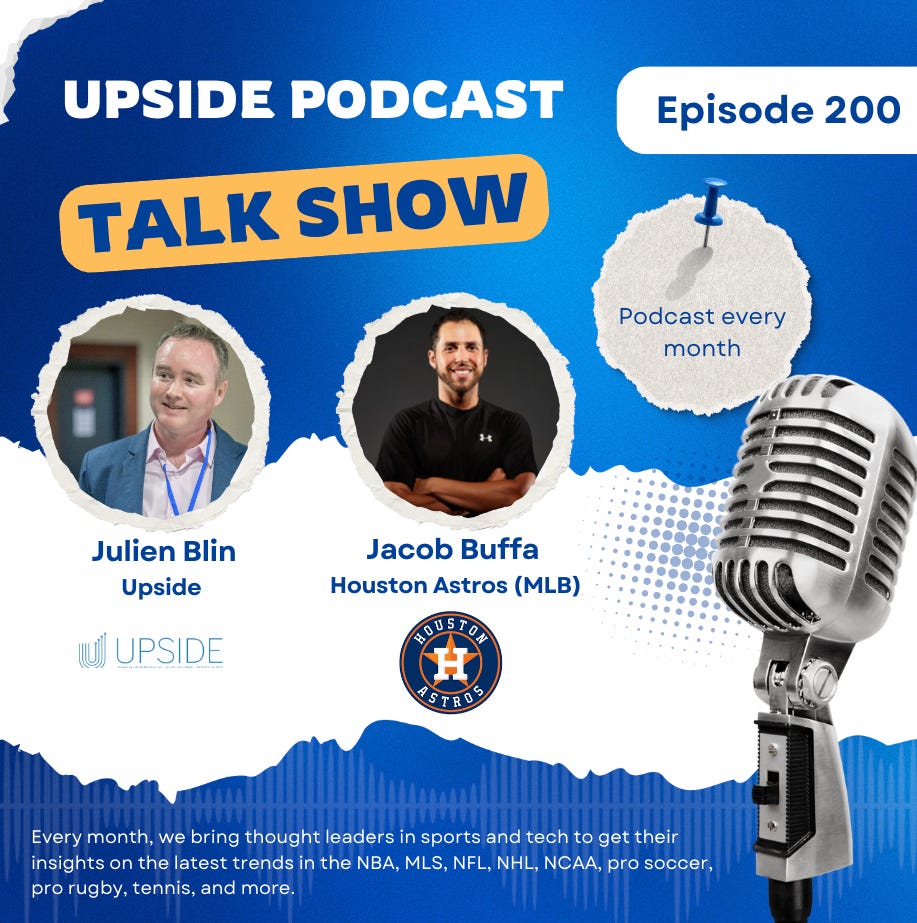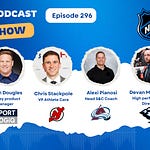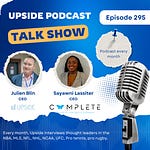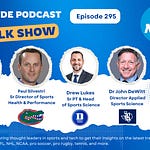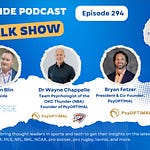Today we have the honor of interviewing Jacob Buffa, the senior director of player development and performance science for the Houston Astros, a top MLB team.
📝Show Notes: Through this interview, we touched on his background, his role for the Houston Astros. And then we discussed his approach towards innovation, injury reduction, as well as his favorite technologies. Lastly we touched on what what he would build if he had unlimited resources and funding.
You can read the full transcript of the podcast interview with Jacob located at the top of this blog post.
Here are some of the best quotes of our conversation with Jacob:
Q1: Please tell me about your background as well as your role for the Astros.
“My background is actually pretty unconventional, I think, for someone in my role. I grew up playing baseball and was a very average baseball player. After graduating from Missouri State University with a degree in marketing and economics—nothing directly related to what I do now—I started a performance company in St. Louis called Elite Baseball Academy. That’s where I began taking a physics-based approach to understanding the physical qualities that dictate on-field performance”.
“I focused on things like force plate research and building databases on amateur and collegiate athletes. That work eventually led me to the Houston Astros in 2019, initially in an entry-level performance coach role. Over the years, I transitioned into sports science, then to building out the performance science department, which now covers biomechanics and player development. It’s been an exciting journey driven by the culture of innovation and collaboration here in Houston.”
Q2: What is your approach towards innovation and injury reduction?
“My approach to research and innovation always starts with asking the question: Does it solve a problem? It’s easy to get caught up in shiny new technologies, but we focus on addressing our core organizational needs. For example, when it comes to injury reduction, we aim to build athletes with high enough physical capacity that the demands of their sport don’t lead to breakdowns”.
“Take hamstring injuries in baseball—there’s not much sprinting in the game, so hamstring injuries shouldn’t be prevalent. We address that by building stronger, more robust athletes. For more complex issues, like elbow injuries in pitchers, we use a targeted approach with workload periodization and look for innovative ways to measure and monitor adaptations in tendons and ligaments. Ultimately, our focus is on understanding injury mechanisms and aligning resources to address them strategically."
Q3: What are your favorite technologies?
"One of my personal favorite tools is force plates. They’re non-invasive, extremely precise, and give us granular data sampled at 500 hertz. They’re reliable and provide descriptive information that’s well-supported in the scientific literature”.
“We also use a suite of other technologies, like GPS devices for workload management and markerless motion capture systems for biomechanical analysis during games. These tools are invaluable for helping us speak a common language across departments—whether it’s scouts, coaches, or strength staff—and ensuring everyone is aligned on what the data is telling us. This shared understanding is crucial for making informed decisions and driving athlete performance."
Q4: What would you build if you had unlimited resources and funding?
"In a perfect world, I would develop an absolutely 100% accurate human pose estimation model. But realistically, since achieving that level of precision is nearly impossible, I’d focus on building a team dedicated to addressing error propagation in computer vision technologies”.
“This would include annotators marking ground truth data to validate skeletal models, experts on camera calibration and intrinsics for stadium setups, and analysts optimizing the speed and accuracy of data pipelines. It’s a highly technical challenge, but understanding the uncertainty in the data we analyze is critical for making better decisions. Investments like this would allow us to take full advantage of the technology at hand while ensuring the results are as reliable as possible."
You may also like:
🔥Upside Chat with Dr Robert Butler, Director of Performance, St Louis Cardinals (MLB) on His Role, Injury Reduction, How to Best Adopt New Technologies
This week we had the honor to interview again Dr. Robert Butler, the Director of performance for the St Louis Cardinals, a top MLB team.


